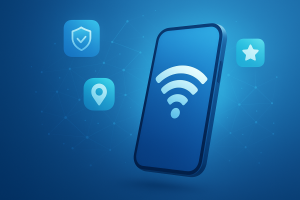Discover Apps to Access WiFi Networks Without a Password
Apps that help you access Wi-Fi networks without having to enter passwords are gaining popularity as they offer convenience in public and home areas. They gather open networks, securely share credentials (when allowed), or help you find free hotspots, making it easier to connect when you're away from home or have forgotten your router password.
While useful, these apps require attention to privacy and legality: Not all methods are appropriate for all situations. In this article, we explain the benefits, basic operation, best security practices, and answer common questions.
Advantages of Applications
Fast connection in public places
These apps let you locate nearby public Wi-Fi hotspots, such as cafes, libraries, and parks, and make connecting easier. Instead of manually searching for networks on your device, you see a curated list with helpful details—distance, ratings, and access type—and can connect in fewer steps.
Collaborative network sharing
Many apps function as communities: trusting users share network information and, in some cases, credentials securely and encrypted. This reduces the frustration of asking the property owner for the password and helps travelers find reliable connections in new cities.
Mobile data savings
By finding free Wi-Fi or sharing access, you can reduce your mobile data usage. For those with limited plans, this means using bandwidth-intensive services—like music streaming or photo backup—without using up your mobile data allowance.
Organization and evaluation of access points
These apps often include ratings and reviews about connection quality, speed, and security. This way, you don't waste time connecting to a slow or unstable network; ratings and feedback from other users help you choose the best access point.
Additional features: VPN, speed test, and diagnostics
Some apps come with built-in tools like speed tests, network troubleshooting, and even basic VPNs. These features increase the app's usefulness, allowing you to check the quality before transmitting sensitive data and secure your connection on public networks.
Guest friendliness on home networks
In domestic settings, certain apps allow you to generate QR codes or temporary links so visitors can connect without revealing the main Wi-Fi password. This simplifies guest access and maintains the security of the main network.
Integration with maps and navigation
Map integration makes it easy to locate public networks around you while traveling. This is particularly useful when you need a stable connection quickly—for example, to send a large file or make a video call.
Alternatives to regain access when the password is forgotten
Some router apps and utilities allow you to recover or reset passwords (when you have administrative permissions). This helps users who have forgotten their router password regain access without immediately contacting technical support.
Reduced time spent on manual configurations
By automating the discovery and connection process, these apps eliminate manual steps like typing complex passwords or navigating configuration menus. For people who use multiple access points throughout the day, the time savings are significant.
Support for multiple devices and connection profiles
Some solutions store connection profiles for different locations (e.g., work, home, gym), automatically adjusting settings like proxy and DNS when you connect. This makes life easier for those who frequently switch between networks.
Frequently Asked Questions
It depends on the use. Locating public networks and using legitimate hotspots is completely legal. However, it is illegal to access private networks without the owner's permission. Apps that attempt to crack passwords or bypass authentication are illegal and insecure. Always use only authorized methods and respect the networks' ownership and usage policies.
Public networks vary greatly in security. Even when an app lists a network as "trusted," follow best practices: avoid accessing sensitive accounts without a VPN, don't conduct banking transactions, and prefer HTTPS sites. Use the app's rating tools and user reviews to choose networks with better reputations.
The vast majority of trustworthy apps don't "steal" passwords—however, malicious apps can collect data. Download only from official stores (Google Play, App Store), check requested permissions, and read reviews. Choose apps with clear privacy policies that explain how credentials are stored and transmitted.
Some apps store passwords locally in encrypted form and allow sharing via QR code or temporary link, while community platforms store access points and authentication methods (e.g., captive portal). Sharing should only occur with the network owner's consent; always check whether the app uses encryption to protect credentials.
Yes. Using a VPN when connecting to public networks significantly increases security by encrypting traffic between your device and the VPN server. Many apps recommend or offer integration with VPNs. Choose a reliable VPN service with a no-logs policy for added privacy.
Look for consistent reviews on official stores, check the number of downloads, read the privacy policy, and review the requested permissions. Well-known developers and established companies tend to be more trustworthy. Avoid apps that request unnecessary permissions, such as access to messages or calls when they're not needed.
Many apps offer the option to automatically connect to previously approved networks, but this can be a security risk if the network is compromised. It's recommended to only configure trusted networks for automatic connection and keep the option disabled for unknown public networks.
Some public networks use captive portals that require registration, acceptance of terms, or login. In these cases, follow the portal's instructions—many apps detect this and open the browser to complete access. Be cautious when entering personal data on these portals and read the terms before accepting.
There are utilities that help you access your router's interface when you have administrative permissions (for example, remembering the password saved on the device itself or using a physical router reset). However, don't use tools that promise to crack third-party passwords. To regain access to your router, follow official procedures: check the device's label, consult the manual, or contact your provider's support.
Keep your operating system and apps up to date, use a VPN whenever possible, disable file sharing on public networks, and don't automatically save passwords when on a public network. Set up two-factor authentication on your important accounts and monitor for suspicious activity.



